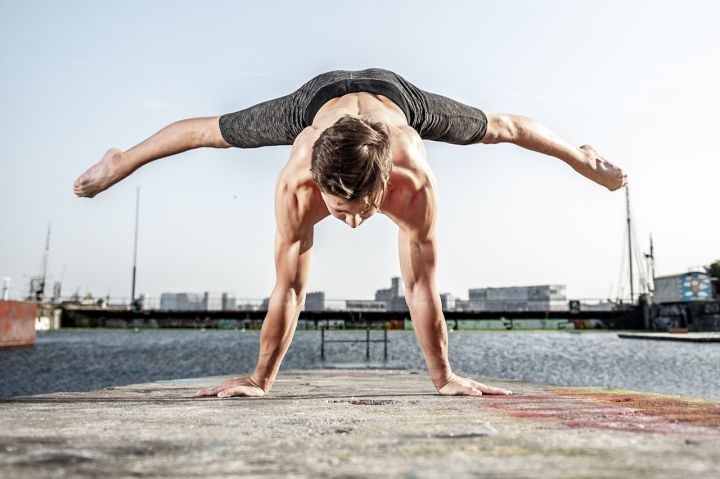in the gym you will often see "Shallow squats" With "Huge weights" On the smith rack, or even just "Shaking" The legs. It's a pointless and more injury-prone way of doing things.
But it also begs the question, how deep should you go when squatting? How far do you squat when you are on a weight and then get up? And what do you expect of yourself when not on a big weight?
Do you often experience the desire to squat lower, but your body won't listen to you? All the influences, the measurements, are now answered and we suggest you concentrate on reading on.

the deep squat is one of the best movements you can do. No matter what your training goals are, doing deep squats regularly will help you reach them faster. The self weighted squat is a great conditioning movement and the barbell squat is one of the best ways to train your quads, gluteus maximus and hamstrings.
Athletes in almost all sports do deep squats to improve their running and jumping performance. The deep squat is also the best movement to test and build strength in the legs. This is why the deep squat is the first movement in a weightlifting competition.

but how deep should you squat? There seems to be only one answer to this question.
In terms of squat depth, we say "Butt to floor", the gym says squat until the hamstrings hit the calves and squat as deep as possible.

but do you really need to squat that deep? If you can't do a full squat does that mean deep squats are worthless? It turns out that not everyone can or should squat to maximum depth, and doing so can lead to injury when you are not fit to squat that deep. There are several factors that determine how deep you can and should squat.
1. Height and leg length
generally speaking, taller lifters have a harder time squatting deeper than shorter athletes. Longer femurs (thigh bones) and torsos increase the distance the weight must travel and also mean that the weight is further away from the base of support (your feet). This increases leverage and difficulty.

these problems can be partially alleviated by adopting a wider than normal squat stance. This allows taller lifters to squat deeper. However, the downside is that a wider squat position can reduce stress on the quadriceps and increase the load on the adductors or inner thighs.
2. Hip flexibility
tight hip muscles can hinder your deep squat depth. Tight hamstrings, the muscles at the back of the thigh, cross over and wrap around the knee and hip joints. If they are tight, they will physically prevent the hips from flexing when squatting. If you try squatting deeper, you may even see a 'hip wink', which refers to the lowering of the pelvis and the rounding of the lower back.

hip inflexibility and the 'hip wink' can lead to injury when you try to squat very deep, especially with heavy weights. Rounding of the lower back increases the pressure on the discs and spinal ligaments. Once injured, these structures take a long time to heal and, in the case of disc injuries, may not heal at all and require surgery to repair.
3. Ankle flexibility
a tight, stiff ankle can have a profound effect on the depth of a deep squat. If the calves are tight, the heels will leave the ground when squatting deeper than parallel. This will make the body unstable, reducing the amount of weight that can be lifted and will also prevent you from squatting deeper.

some lifters wear high heeled weightlifting shoes to solve this problem, while others will choose to step on a barbell piece or plank with their heel in the deep squat. While these methods allow you to squat a little deeper, they only treat the symptoms without addressing the cause of the ankle inflexibility. If tight calves are preventing you from squatting very deep, the best solution is to stretch.
4. Types of deep squats
if you want to squat deeper, some variations are better. The barbell front squat and kettlebell squat are the best types of squats for doing fluid, deeper squats. A close second is the high bar squat, which is a squat with the high bar on the upper trapezius. All of these types of squats keep your body upright, which usually allows for a deeper squat.

the low bar squat, where the barbell is placed lower on the shoulders, is the worst type of squat in the deep squat. The low bar squat promotes forward leaning of the body. This is great for weightlifting, but not so great for squatting deep. The low bar squat is popular in powerlifting.
5. Knee condition
the knee is a synovial hinge joint, consisting of two bones with smooth, tough, clear cartilage covering the ends of the bones and lubricated by synovial fluid. This joint opens and closes like a hinge, hence the name.
Synovial joints are prone to wear and tear. Wear and tear causes rough surfaces to form within the joint, which can affect range of motion and mobility. If you have been training for a long time, or are a little older, your knee joint may not be able to squat deep. In addition, a previous injury to the knee may mean that deep squats are no longer possible or desirable.

6. Too much weight
many exercisers do not squat deep enough when lifting heavy weights. After all, if the squat is not deep enough, the weight will not move as far and can be done more times. In most cases, this is a form of self-deception and squatting deeper with lighter weights will work better.
You wouldn't do half bench presses or bicep curls, so don't do half squats either. The only exception to this rule is if you are training to improve your vertical jump performance. Studies have shown that half-range squats are an effective way to improve jump height.

7. Reasons for deep squatting
your ideal deep squat depth is not only based on anatomy and physiology, but also depends on the individual's specific training goals. Weightlifters only need to squat until their thighs are parallel to the ground. Squatting deeper is just a waste of energy and reduces the amount of weight lifted.
In contrast, olympic lifters need to do deep squats during the snatch. This allows them to get really under the bar, so they can lift heavier weights.
Bodybuilders and trainers in general train for results, not to see how much weight they can lift. The depth of the squat is not the most important thing, and to a certain extent a shallow, heavy squat is just as effective as a deep, light squat because both deep and shallow squats give you some form of stimulation of the target muscles.

however, as range of motion is important for muscle growth, most trainers should usually avoid very shallow deep squats.
So, how deep should you squat?
If you are a weightlifter, it is important to squat to the correct depth, i.e. Thighs parallel to the floor, for counting lifts. Some leagues are stricter than others, but you should ensure that you achieve the required depth for competition in training.
If you cannot achieve the correct depth, you will need to work on hip and ankle flexibility.
Bodybuilders and general trainers should squat as deep as possible without causing a 'hip wink'. When you squat deep, look at your pelvis in the mirror and stop the movement before your buttocks retract. Try to achieve the same depth on every movement.

while there is no need to force yourself to squat deeper than is comfortable, you should not shorten the depth either. Regardless of leg length, hip and ankle flexibility, and the type of squat being done, most lifters should be able to achieve the same depth as a powerlifter, where the thighs are close to parallel to the ground.
If you are unable to achieve this depth then you may need to train flexibility or reduce the weight when squatting.
Now that you know the factors that affect squat depth, you should understand why some people can squat deeper than others and why some people may never be able to do a full full squat. Some factors, such as height, leg length and knee health, cannot be changed. Other factors, such as hip and ankle flexibility, can be improved to increase the depth of the squat.

remember, however, that there is no need to do a full squat if you cannot or do not want to. Instead, squat as deep as you can to give you the results you want and the lowest risk of injury. Don't shorten your reps, but don't squat so deep that you feel intimidated either. A back injury due to blinking hips may prevent you from doing deep squats at all.





